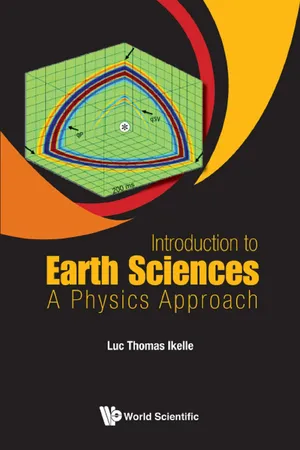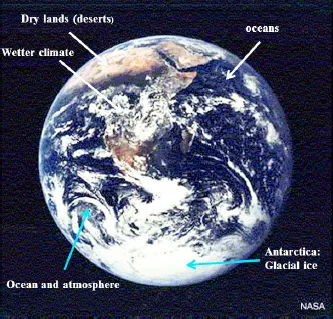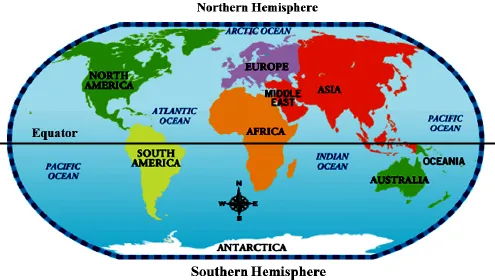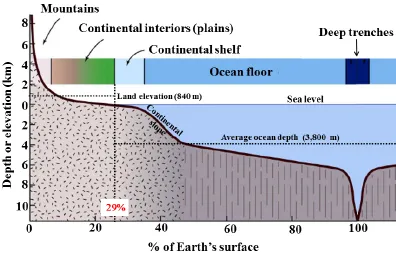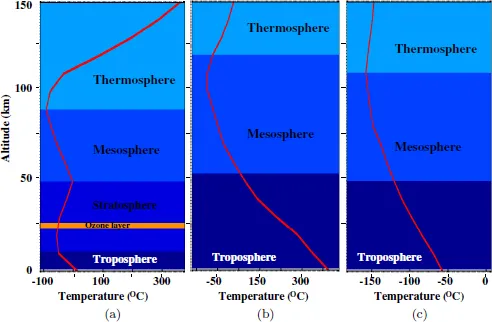![]()
Chapter 1: A View of Earth: The Earth’s Spheres
1.THE ATMOSPHERE
1.1.Composition
1.2.A layer model
1.3.Some other atmospheres in the solar system
2.THE HYDROSPHERE
2.1.Saltwater and fresh waters
2.2.The water cycle
3.THE BIOSPHERE
3.1.Composition
3.2.The deep biosphere
4.THE LITHOSPHERE
4.1.A layer model of solid earth
4.2.The rock cycle
Our objective in this chapter and the next one is to recall some of the basic notions of the earth sciences, especially the earth’s composition, and to introduce seismic waves, thus allowing us to understand the solid earth’s interior before we turn to the key topics of this book, which are (i) Earthquakes and volcanoes, (ii) energy resources, and (iii) climate change.
Let us start with a view of the earth from space, as seen through the Apollo program — more precisely Apollo 17, as depicted in Figure 1.1. Notice that the Saharan dry land and the wet sub-Saharan — water is almost everywhere on Earth, including oceans and glacial ices, as we will discuss later. A close look at the earth’s surface (Figure 1.2) shows that 61 percent of the northern hemisphere is covered by water, and 81 percent of the southern hemisphere is covered by water. However, on a planetary scale, the ocean is small. In fact, there is more water within the earth’s interior than in its oceans and atmosphere. Note that Earth’s surface is not flat; it has topography. Ignoring oceans, Earth’s surface is dominated by two distinct elevations: most land is 0–2 km above sea level, and most of the sea floor is 3–5 km below sea level (Figure 1.3).
Figure 1.1: A view of the earth from space through Apollo 17. Taking a full photograph of Earth from space takes some doing. In 1972 the crew of Apollo 17 took a camera to the moon in order to bring the full sphere into view. At a time when our planet is undergoing critically important changes, this type of global views offers vitally important information about how Earth is changing.
As we go through this chapter and this book’s subsequent chapters, it is important that you refamiliarize yourselves with the major features of the earth’s surface, namely the seven continents (Africa, Antarctica, Asia, Australia, Europe, North America, and South America), the five oceans (the Antarctic Ocean, the Arctic Ocean, the Atlantic Ocean, the Indian Ocean, and the Pacific Ocean) and the major mountain ranges (the Himalayan mountains in Asia, the Alps in Europe, the Andes in South America, the Rockies and Mount St. Helens in North America, Mount Pinatubo in the Philippines, and Mount Kea and Mount Loa in Hawaii) on the earth’s surface. Other useful statistics to keep in mind are that the average land elevation is 840 meters, the average ocean depth is 3,800 meters, the average ocean temperature is 3.9°C (degrees Celsius), and the average global temperature is 14.6°C. About 50 percent of the earth’s population lives less than 240 km from an ocean. In Japan, by contrast, 96 percent of the population lives less than 100 km from the ocean.
Figure 1.2: Another view of the earth showing the seven continents (Africa, Antarctica, Asia, Australia, Europe, North America, and South America) and the five oceans (the Antarctic Ocean, the Arctic Ocean, the Atlantic Ocean, the Indian Ocean, and the Pacific Ocean).
Figure 1.3: A schematic illustration of the relative heights of the major features of the earth’s surface. The horizontal axis, labeled “% of Earth’s surface,” gives the percentage, whereas the vertical axis shows the elevation above or below sea level. Sea level is the mean sea level (an average level of the surface of Earth’s oceans). This illustration also shows that the earth has two types of crust, continental and oceanic. (Adapted from Encyclopaedia Britannica inc, 2010)
We generally divide the earth into four spheres: (i) the atmosphere, (ii) the hydrosphere, (iii) the biosphere, and (iv) the lithosphere. The atmosphere is a thin gaseous envelope surrounding Earth. The hydrosphere is the water, primarily the oceans. The biosphere includes all living things on the planet. The lithosphere is the rocky outer shell of the earth. All these spheres — the lithosphere, the hydrosphere, the atmosphere, and the biosphere — are linked through flows of mass, energy, and life. Their interactions have affected the development of our planet. Solar energy is essential to the function of each of these spheres and for the entire system. Note that the word cryosphere is often used to describe the frozen water in the earth’s system and includes frozen parts of the oceans, such as the waters surrounding Antarctica and the Arctic, which are here considered part of the hydrosphere. Let us now describe in a little more detail the atmosphere, the hydrosphere, the biosphere, and the lithosphere.
1THE ATMOSPHERE
1.1Composition
The atmosphere is unique in the solar system because it provides the air we breathe and protects us from the Sun’s intense heat. It is thin (90 percent of it occupy 16 km) and tenuous. It is composed of 78 percent nitrogen (N2), 21 percent oxygen (O2), 0.9 percent argon (Ar), and minor amounts of carbon dioxide, methane, and water vapor. In other words, three gases — nitrogen, oxygen, and argon — represent 99.9 percent of the gases in the atmosphere. Yet some of the gases that make up the remaining 0.1 percent (such as carbon dioxide, methane, and water vapor) can have huge effects on the earth’s climate and therefore on our living conditions. We will come back to this issue in Chapter 6. Note that three billion years ago, oxygen was not present, and therefore there was no life as we know it today. The photosynthesis of plants, which began about three billion years ago, put oxygen into the atmosphere. Photosynthesis is a process used by plants and other organisms to convert light energy, usually from the Sun, into chemical energy that later can be released to fuel the organisms’ activities. This process has produced oxygen and removed carbon dioxide (CO2) and methane (CH4) from the atmosphere. It is remarkable that the photosynthesis of plants put oxygen in the atmosphere at the right percentage, 21 percent. Why not less — say, 15 percent? If so, there would not be human life on Earth as we know it today. Photosynthesis is a complex process that is still widely investigated.
1.2A layer model
The atmosphere is generally divided into several layers, as depicted in Figure 1.4a. This division is essentially based on the temperature profile. The ground is shown in a dark color at the bottom of this figure. The approximate altitude in kilometers is given in the right-hand scale. The approximation here is caused by the fact that the altitudes of the layer boundaries vary with the topography of the earth’s surface. We cannot expect these boundaries to have the same altitudes above the highest peak of the Himalayas and above sea level. The peak of the Himalayas is about 8 kilometers above sea level.
Figure 1.4: (a) This drawing shows the layers of the earth’s atmosphere. The altitude in kilometers is given on the right-hand scale and is approximate. (Click for a larger image.) (b) This drawing shows the different layers of Mars’s atmosphere. Mars is too small to keep a thick atmosphere. The atmosphere of the earth is a hundred times thicker. (c) This drawing shows the different layers of Venus’s atmosphere. Venus has almost the same mass as Earth but a thicker atmosphere, which is composed of 96 percent carbon dioxide.
Let us now briefly describe the layers of the atmosphere. (i) the troposphere is the lowest atmospheric layer, as we can see in Figure 1.4a. It is about 11 km thick. Most clouds are found in the troposphere. The troposphere is thinner at the poles (averaging about 8 km thick) and thicker at the equator (averaging about 16 km thick). The temperature in the troposphere decreases with altitude. (ii) The stratosphere ranges from 11 to 48 kilometers above the earth’s surface. The stratosphere contains the ozone layer, which absorbs most of the harmful ultraviolet radiation from the Sun. The temperature in the stratosphere increases slightly with the altitude. The highest temperature in this region is about zero degrees Celsius (i.e., 32 degrees Fahrenheit). (iii) The mesosphere is obviously above the stratosphere, between about 45 and 95 km in altitude. It is characterized by a rapid decrease in temperature with altitude; the temperature is about −90 degrees Celsius (130 degrees Fahrenheit) at the top of the mesosphere. (iv) The thermosphere starts at about 95 km above the earth’s surface. This temperature is quite high. Note that its temperature is not measured with a thermometer but by looking at the motion and speed of the rarefied gases in this layer, which are very energetic but would not affect a thermometer. Temperatures in this layer may be as high as thousands of degrees Celsius. (v) The exosphere is the layer beyond the thermosphere. (vi) The ionosphere overlaps the other atmospheric layers above the earth. The air is ionized1 by the Sun’s ultraviolet light. These ionized layers affect the transmittance and reflectance of radio waves. We will discuss this issue in the climate-change chapters. Note that the exosphere and the ionosphere are not shown in Figure 1.4a. Note also that pressure in the atmosphere decreases with increasing altitude. Basically, pressure is caused by the weight of any overlying material. The upper atmosphere has less material above it; therefore its pressure is lower.
1.3Some other atmospheres in the solar system
In addition to Earth, many of the other planets in the solar system have atmospheres (Figure 1.5), including Mars and Venus. Venus’s atmosphere is composed mostly of carbon dioxide. It also contains minor amounts of nitrogen and other trace elements, including compounds based on hydrogen, nitrogen, sulfur, carbon, and oxygen. Though shallower than that of Earth, the atmosphere of Venus is much hotter and denser than Earth’s. As green-house gases (carbon dioxide and methane) warm the lower atmosphere, they cool the upper atmosphere, leading to a compact thermosphere. Based on the temperature profile of Venus’s atmosphere, as shown in Figure 1.4b, we can see that Venus has no stratosphere. Its troposphere extends to an altitude of 65 km (an altitude at which the mesosphere has already been reached on Earth). At the top of the troposphere, temperature and pressur...
